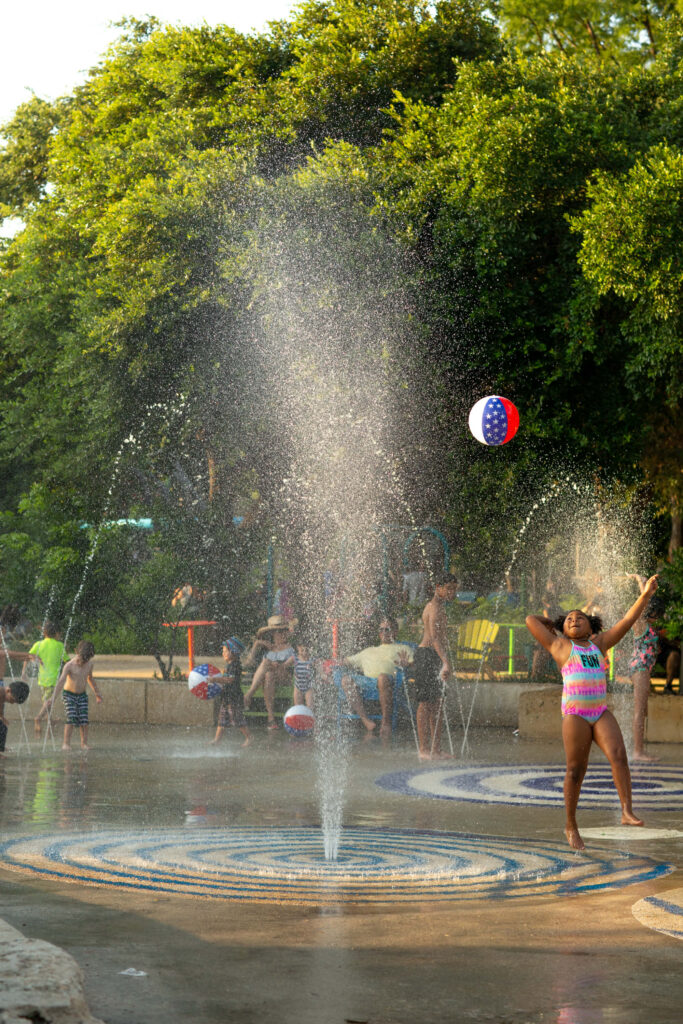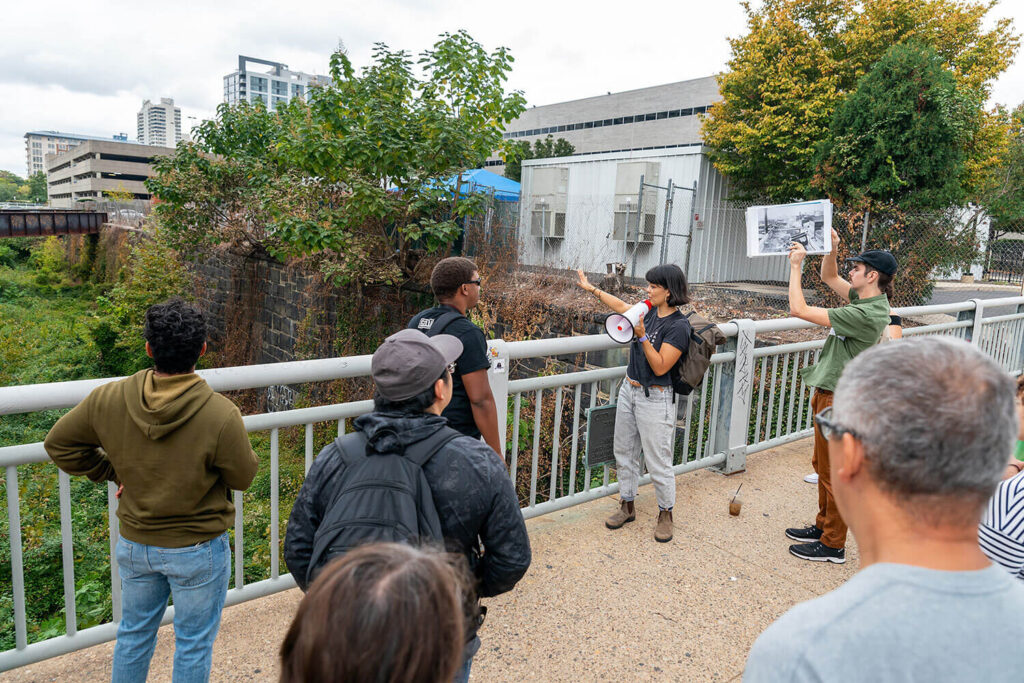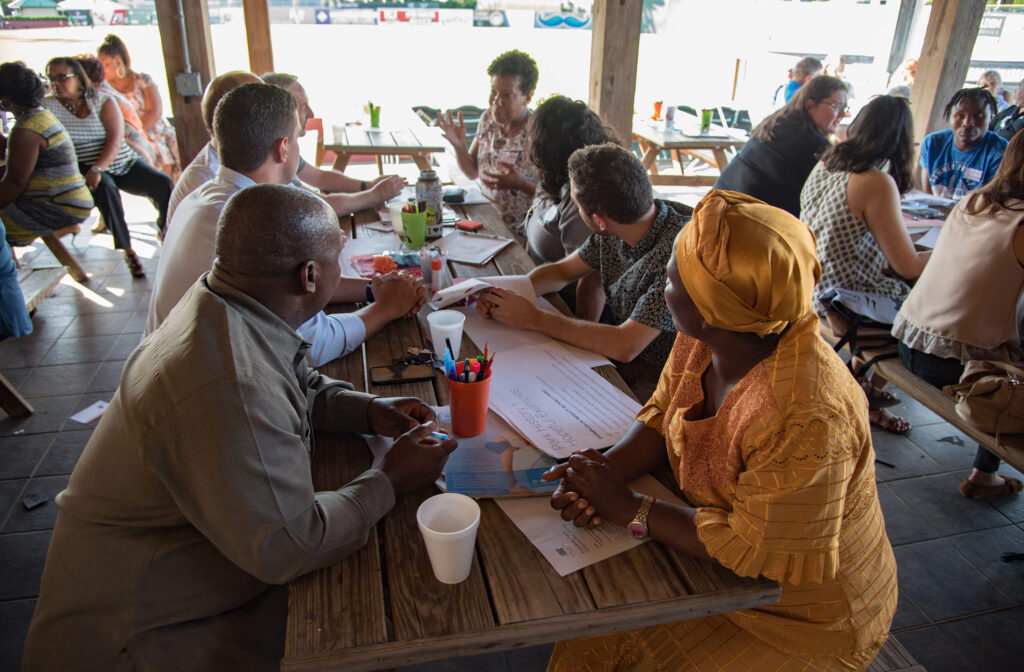Would you like to showcase your own work to embed equity in your infrastructure reuse project?
Connecting the dots: from sustainable design to sound fundraising efforts

Children enjoying water features at Hemisfair. Credit: Hemisfair
Hemisfair, located in the heart of San Antonio, Texas, is a 40-acre urban district with three parks, residences, businesses, and public programs. The district is supported by Hemisfair Park Area Development Corporation and the Hemisfair Conservancy, a joint effort which better positions the district to pursue a range of issues. Some of these include community engagement in sustainability measures or site-specific fundraising, which at Hemisfair are closely linked.
San Antonio’s ecosystem is a hot arid desert, which can be a challenge for public space design and activation. However, harsh environmental conditions can be overcome when resilience is a goal. From the project outset, Hemisfair was determined to find alternative methods of water collection. The organization then prioritized three parks: Yanaguana Garden, Civic Park, and Tower Park, building systems to integrate water catchment. Yanaguana Garden was designed with a splash pad: testing the efficacy of bio-swells in filtering and reintegrating run-off water. This system captures 91.99% water from the splash pad and processes it for reuse. The system can detect when water is not properly filtered and automatically shuts down, keeping kids safe.
Another environmentally-focused innovation was created when the largest of the three parks, Civic Park was envisioned. Currently under construction, it will be complete in 2023, accommodating over 15,000 visitors. Here, Hemisfair sought creative solutions for water maintenance. A rainwater collection system ensures runoff captured during rainy months will be filtered and stored for drier months. This space has an additional system that captures, treats, and re-integrates condensation collected from air conditioning units from the district’s buildings. However, the largest contributor to makeup water is referred to as “nuisance water.” This water is found on site when piers and basements reach the water table. A system to collect and purify this “found” water has been integrated into the water supply and treatment for use in irrigation and water feature supply. Implementing these sustainability measures involved close engagement with community stakeholders. Hemisfair had to clearly explain, through a series of engagement tools such as pamphlets, meetings, and site visits, the positive impacts these measures would have on water quality available at the park. They served as a valuable basis for community engagement and teaching opportunities. Environmental sustainability was introduced to the public during master plan visioning sessions. Today, the park is exploring alternative energy sources and is a testing ground for electric car charging stations and solar panels. The annual Solar Community Celebration is one way the park engages the community in renewable energy planning.
Sustainability at Hemisfair extends to plantings too. Trees and the shady canopy they provide are essential to mitigating heat island effect in Downtown San Antonio. Four years ago Hemisfair made the strategic decision to purchase over 200 mature trees, anticipating that by the 2023 opening, the trees would be large enough to offer instant shade to visitors. This decision sparked an innovative philanthropic program initiated by The Hemisfair Conservancy where individuals, companies, and organizations could sponsor the planting of a mature tree and the purchase of a new tree through a one-time gift of $7,000. This model was exciting for donors and was marketed as one of the only ways to have a lifelong impact on the park and direct impact on the health and safety of residents.
Hemisfair, located in the heart of San Antonio, Texas, is a 40-acre urban district with three parks, residences, businesses, and public programs. The district is supported by Hemisfair Park Area Development Corporation and the Hemisfair Conservancy, a joint effort which better positions the district to pursue a range of issues. Some of these include community engagement in sustainability measures or site-specific fundraising, which at Hemisfair are closely linked.
San Antonio’s ecosystem is a hot arid desert, which can be a challenge for public space design and activation. However, harsh environmental conditions can be overcome when resilience is a goal. From the project outset, Hemisfair was determined to find alternative methods of water collection. The organization then prioritized three parks: Yanaguana Garden, Civic Park, and Tower Park, building systems to integrate water catchment. Yanaguana Garden was designed with a splash pad: testing the efficacy of bio-swells in filtering and reintegrating run-off water. This system captures 91.99% water from the splash pad and processes it for reuse. The system can detect when water is not properly filtered and automatically shuts down, keeping kids safe.
Another environmentally-focused innovation was created when the largest of the three parks, Civic Park was envisioned. Currently under construction, it will be complete in 2023, accommodating over 15,000 visitors. Here, Hemisfair sought creative solutions for water maintenance. A rainwater collection system ensures runoff captured during rainy months will be filtered and stored for drier months. This space has an additional system that captures, treats, and re-integrates condensation collected from air conditioning units from the district’s buildings. However, the largest contributor to makeup water is referred to as “nuisance water.” This water is found on site when piers and basements reach the water table. A system to collect and purify this “found” water has been integrated into the water supply and treatment for use in irrigation and water feature supply. Implementing these sustainability measures involved close engagement with community stakeholders. Hemisfair had to clearly explain, through a series of engagement tools such as pamphlets, meetings, and site visits, the positive impacts these measures would have on water quality available at the park. They served as a valuable basis for community engagement and teaching opportunities. Environmental sustainability was introduced to the public during master plan visioning sessions. Today, the park is exploring alternative energy sources and is a testing ground for electric car charging stations and solar panels. The annual Solar Community Celebration is one way the park engages the community in renewable energy planning.
Sustainability at Hemisfair extends to plantings too. Trees and the shady canopy they provide are essential to mitigating heat island effect in Downtown San Antonio. Four years ago Hemisfair made the strategic decision to purchase over 200 mature trees, anticipating that by the 2023 opening, the trees would be large enough to offer instant shade to visitors. This decision sparked an innovative philanthropic program initiated by The Hemisfair Conservancy where individuals, companies, and organizations could sponsor the planting of a mature tree and the purchase of a new tree through a one-time gift of $7,000. This model was exciting for donors and was marketed as one of the only ways to have a lifelong impact on the park and direct impact on the health and safety of residents.
Share this Case Study


